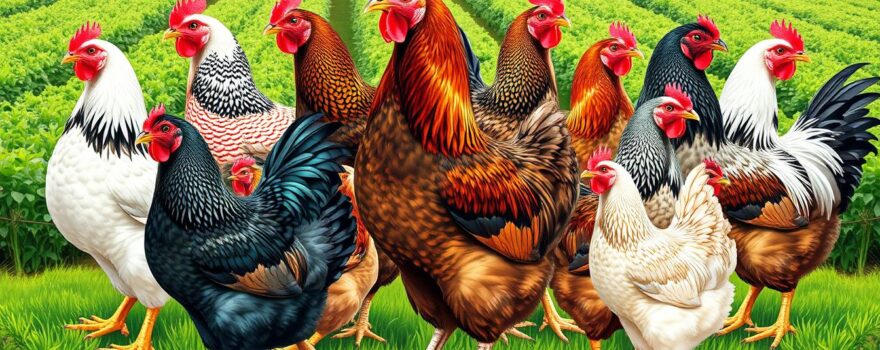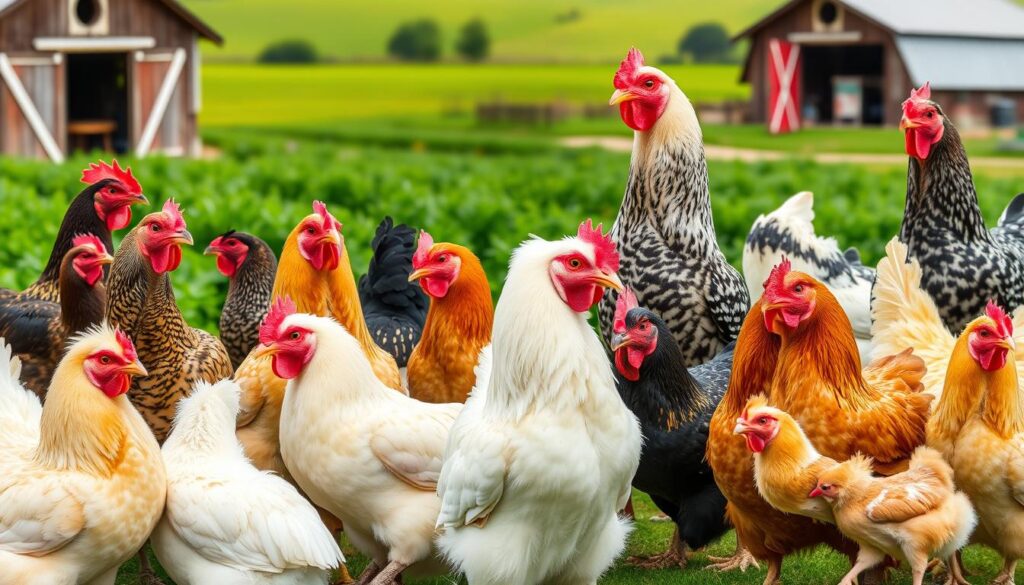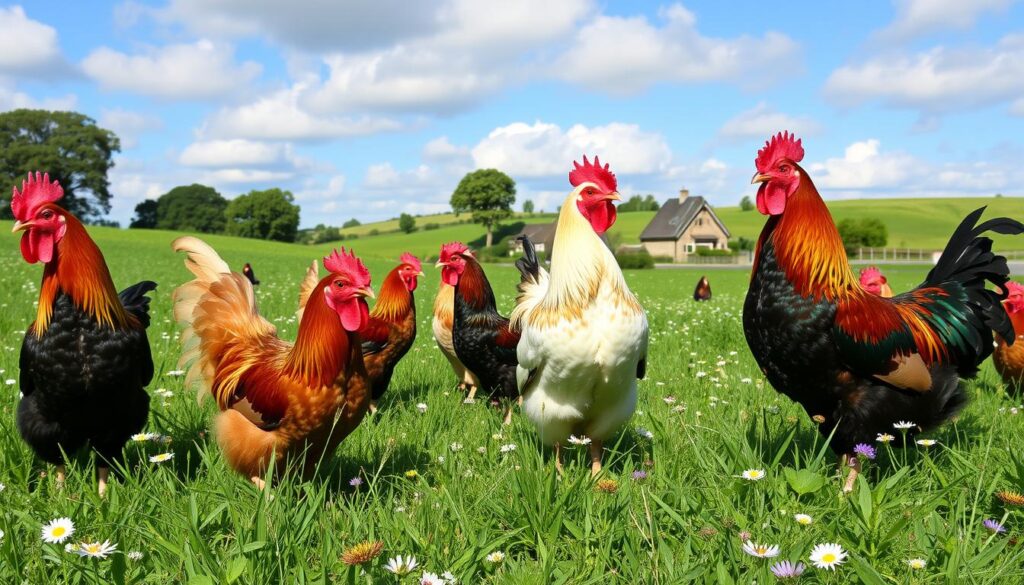
Domesticated chickens, or Gallus gallus domesticus, are found all over the world. They came from the red jungle fowl, which was domesticated in Asia. As chickens spread out, they formed new breeds and lines. This movement led to less genetic diversity within these populations.
This study looks at how genetic diversity in domesticated chickens relates to their genetic distance from wild chickens. It aims to understand the patterns of genetic diversity in poultry genetics and chicken genomics of broiler breeding programs.
The study’s findings shed light on the relationship between genetic variation and population structure in SNP genotyping of broiler chickens. It explores genetic distances and diversity. This research helps in creating effective selective breeding strategies, inbreeding management techniques, and sustainable poultry production practices.
Introduction to Chicken Genetic Diversity
Understanding chicken genetic diversity is key to keeping their genetic resources safe and improving breeding. Chickens were first domesticated from wild junglefowl in Asia. As they spread to different areas, their genes were influenced by chicken population migration, genetic isolation by distance, founder effects, and genetic differentiation.
Migration of Chicken Populations
Chickens moving from their chicken domestication centers in Asia likely increased genetic differentiation. This is similar to how human populations evolved. But, unlike humans, chickens’ genetic changes are mainly due to crossbreeding and selective breeding.
This study looks at Reynolds’ genetic distances to understand genetic differentiation. By studying chicken populations’ genes, researchers can see how migration and isolation affected them. This helps us understand the genetic diversity of these important animals.
“The movement of chicken populations away from their founders is expected to increase genetic differentiation, similar to the “Out of Africa” theory in human populations.”
Relationship Between Genetic Diversity and Distance from Wild Populations
Researchers have found a fascinating link between genetic diversity and how far domesticated chickens are from their wild ancestors. A study by Malomane et al. (2019) created a global tool to study chicken diversity. They discovered that 87.5% of the variation in domesticated chicken diversity is linked to how close they are to wild populations.
The study showed that the genetic distance to wild populations explains a lot of variation in chicken diversity. This variation ranges from 81.7% to 88.7% across different parts of the chicken’s genome. This means that genetic diversity changes at different rates in different parts of the genome.
The study found that genetic diversity changes faster in certain genes. These genes are involved in important functions like transporting proteins and lipids. On the other hand, genes that are crucial for survival show less change in genetic diversity. This is true even as the genetic distance to wild types changes.
| Genetic Distance to Wild Populations | Variation Explained in Genetic Diversity |
|---|---|
| Overall Genetic Diversity | 87.5% |
| Across SNP Classes | 81.7% to 88.7% |
This research highlights the complex nature of genetic diversity in domesticated chickens. It shows how genetic diversity is shaped by various factors like mutations and selection. These findings can help us better understand chicken evolution and adaptation. They also guide us in managing and conserving chicken populations.
Understanding Genetic Diversity in Broiler Chicken Populations
Researchers have done a detailed study on the genetic diversity of domesticated chickens. They looked at how these chickens compare to their wild counterparts. They used a global collection of 160 chicken breeds to understand their evolution.
The study focused on different parts of the chicken’s genome. It looked at how genetic diversity changes in various regions. This helps us understand the evolution of broiler chickens better.
This research gives us a better grasp of genetic diversity in broiler chickens. It shows how genetic diversity relates to their distance from wild chickens. It also highlights differences in different parts of the genome. This knowledge is crucial for genetic conservation and breeding.
“This study represents a significant step forward in our understanding of the complex genetic landscape of broiler chicken populations and their evolutionary trajectories.”
The study’s approach is thorough, using global samples and detailed genomic analysis. It offers a framework for further research and understanding. This knowledge can help in managing and preserving genetic resources for broiler chickens.

Impact of SNP Classes on Genetic Diversity
Genetic diversity is key for any population. It helps us understand how different genomic regions vary. Recent studies have shown how different SNP classes affect the genetic diversity of broiler chickens.
Non-Synonymous SNPs and Functional Genes
Non-synonymous SNPs stand out for their impact on genetic diversity patterns. These SNPs change amino acids in proteins. They are linked to genes crucial for growth and survival.
Researchers found that genetic distance to wild chickens still matters a lot. It explains 83.0 to 89.3% of the variation in chicken diversity. This means genes with little variation are likely key to the species’ survival.
But, genes involved in protein transport and metabolism change faster. These genes adapt to population needs, helping chickens stay resilient.
| SNP Class | Genetic Diversity Explained by Distance to Wild |
|---|---|
| Non-Synonymous | 83.0% |
| Synonymous | 84.1% |
| Intergenic | 89.3% |
| Intronic | 87.2% |
These discoveries show the intricate link between genetic diversity, SNP classes, and functional genes in broiler chickens. Knowing this helps in breeding and conservation. It keeps the genetic diversity of this vital livestock species in balance.
Local Chicken Breeds and Genetic Resources
Local chicken breeds are key in the face of big commercial poultry farms. They are adapted to local climates and farming ways. These traits could help them face climate change and new farming needs.
Importance of Local Breeds
Local chicken breeds, like those in France, are vital for the poultry industry’s future. They’ve grown to survive in their areas, fighting off diseases and harsh weather. They also need less food, which is good for free-range farming and sustainable poultry production.
But, these breeds are at risk of disappearing. They’re outcompeted by commercial birds and small farms are fading. It’s important to save these genetic resources for future use and to adapt to climate change.
“Local chicken breeds may represent a valuable reservoir of genetic diversity for future breeding, as they may harbor unique adaptive features that could be important for adapting to climate change and new farming conditions.”
By valuing local chicken breeds and their genetic resources, the poultry industry can become more sustainable and strong. It can adapt to environmental and market changes. With conservation and breeding efforts, these local genetic resources can boost the poultry sector’s ability to face climate change and other challenges.
Management Programs for French Local Chicken Breeds
In France, efforts are underway to save the genetic diversity of local chicken breeds. These efforts include keeping detailed records of each bird’s ancestry. They also involve careful planning of who mates with whom and choosing parents wisely. This helps keep the special traits of these breeds alive.
A recent study looked at 22 French local chicken breeds and 4 commercial ones. It used both DNA analysis and demographic data to assess their genetic diversity.
The study found that the genetic diversity of French local chicken breeds is high. This is thanks to the management programs in place. These programs have been successful in keeping the genetic diversity of these French local chicken breeds alive.
| Statistic | Findings |
|---|---|
| Breeds Studied | 22 French local breeds and 4 commercial lines |
| Genetic Diversity Levels | High between- and within-breed genetic diversity |
| Management Programs | Effective in conserving genetic diversity |
| Molecular Tools | Useful for monitoring small populations without pedigrees |
| Breed as Operational Unit | Appropriate for genetic diversity conservation, including consideration for varieties |
The study shows that France’s management programs are working well. They focus on keeping detailed records, planning who mates with whom, and choosing parents carefully. These efforts are crucial in saving the unique traits and heritage of these French local chicken breeds.

The study also points out the value of using DNA tools to check on small populations. This method is especially helpful when pedigree information is scarce. It helps us understand the genetic makeup and diversity of these local chicken breeds.
“The breed was recognized as an appropriate operational unit for genetic diversity conservation, including consideration for varieties in local breeds.”
In summary, the management programs for French local chicken breeds are doing a great job. They are keeping the genetic diversity of these important breeds alive. With continued support, we can ensure these unique poultry breeds are around for future generations.
Genetic Structure of Chicken Populations
Researchers have studied the genetics of chicken populations around the world. They’ve uncovered their origins, how they were domesticated, and how they evolved. A recent study looked at the genomes of 863 chickens, giving us new insights into their ancestry and traits.
They found 14 new genes related to meat quality in chickens. This discovery can help improve breeding programs for broilers.
Clustering and Stratification of Populations
Genetic studies have been done on many chicken breeds. This includes both local and commercial breeds. For example, studies on Chinese chickens in Guizhou Province and Southern Xinjiang, and the Dulong Chicken, have shown unique genetic traits.
Whole-genome sequencing and mitochondrial DNA analysis have updated our understanding of chicken domestication. They’ve traced their origins and migrations. Genome-wide data also showed that Chinese breeds mixed with commercial lines, showing the need to save local genetics.
Clustering analyses, like those using STRUCTURE software, have revealed the genetic ties among different chicken populations. They’ve found distinct genetic groups based on where they come from, their breeding history, and their purpose, like laying eggs or being broilers.
Advanced genetic methods have helped researchers understand the complex genetics of chickens. These methods include principal component analysis, pairwise FST calculations, and effective population size estimation. These findings are key for conserving chicken genetic resources and improving production traits.
Challenges and Strategies for Conserving Genetic Diversity
Keeping genetic diversity alive is key for poultry farming’s future, especially with climate change looming. Yet, many local chicken breeds face extinction due to their small numbers. This makes them more likely to suffer from inbreeding and genetic drift. To save these breeds, we need to manage their populations well.
For example, French local breeds have shown success with programs that track their ancestry, plan their breeding, and select them carefully. Molecular tools can also help by checking the genetic health of these breeds when we don’t have much history on them.
It’s vital to keep the genetic diversity of local chicken breeds alive. This ensures that poultry production systems can adapt and survive future challenges, like climate change adaptation.
| Challenge | Strategy |
|---|---|
| Small population sizes | Develop effective population management programs, including pedigree recording, optimized mating plans, and moderate selection |
| Inbreeding and genetic drift | Utilize molecular tools to monitor genetic diversity in local populations with limited pedigree information |
| Adaptability and resilience | Conserve the genetic diversity of local chicken breeds to ensure the sustainability of poultry production systems in the face of climate change |
Protecting the genetic diversity in chicken populations is crucial for the poultry industry’s future. By using smart management and molecular tools, we can keep local chicken breeds valuable for sustainable poultry production and climate change adaptation.
This study sheds light on genetic diversity in broiler chickens. It shows how distance from wild populations and SNP classes affect it. It also talks about the importance of local chicken breeds as genetic resources.
The study found that management programs can save local chicken breeds’ genetic diversity. This is seen in France’s success with their local breeds. These findings help us understand chicken genomes better and how to keep their genetic diversity for sustainable farming.
The research found millions of SNPs in broiler chickens and breed-specific ones too. It showed local chicken breeds are key genetic resources. Conservation programs in France have kept their genetic diversity alive.
This underlines the need for a balanced approach in poultry management. We must improve productivity while keeping genetic resources for sustainability.
The study also pointed out the challenges in improving broiler chickens’ fitness and growth. It shows we need smarter breeding strategies. These should consider all traits and keep genetic diversity high.
By using insights from this research and innovative resource populations, we can improve poultry breeding. This will help the industry face challenges like climate change.